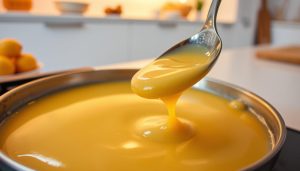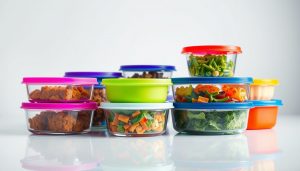Did you know over 70% of U.S. kitchens use cookware with slippery surfaces that trace their origins to a lab accident in 1938? This innovation revolutionized cooking by eliminating scrubbing and excessive oil. At its core, these surfaces rely on a synthetic polymer called polytetrafluoroethylene (PTFE), better known by its brand name Teflon. Its secret lies in carbon-fluorine bonds, some of the strongest in chemistry, which create an invisible shield against sticking.
PTFE’s molecular structure resembles a smooth, tightly packed fence. Fluorine atoms form an outer layer so slick that even sticky foods like eggs or melted cheese glide off effortlessly. Manufacturers apply this material through high-temperature processes, bonding it to metals like aluminum to ensure durability. The result? A surface so low-friction it’s 300 times smoother than water on glass.
Beyond pans, this technology shapes everyday items. Waterproof jackets, electrical wires, and stain-resistant fabrics all benefit from similar principles. Yet most people interact with it daily while flipping pancakes or reheating leftovers. Understanding its science helps you choose quality products and avoid overheating risks.
Key Takeaways
- PTFE (Teflon) uses carbon-fluorine bonds to create ultra-slippery surfaces
- High-temperature application ensures coatings bond securely to cookware
- The technology originated from accidental discoveries in the 1930s
- Nonstick principles apply to clothing, wires, and industrial materials
- Proper use prevents damage and extends cookware lifespan
The Science Behind Nonstick Coatings
What gives your frying pan its slippery superpowers? The answer lies in PFAS chemistry—a family of synthetic substances with carbon-fluorine bonds stronger than diamond crystals. These “forever chemicals” form the backbone of modern nonstick surfaces through precise engineering at the molecular level.

Understanding PTFE and PFAS Chemistry
PFAS (per- and polyfluoroalkyl substances) act like microscopic armor for cookware. During manufacturing, individual molecules fuse into polymer chains through heat-driven polymerization. This creates a dense, smooth layer that repels food particles. Unlike older formulations containing PFOA or PFOS—now phased out in the U.S.—modern coatings use safer alternatives while maintaining performance.
How Polymerization Creates a Nonstick Surface
Factories bake these polymers onto metal at 500°F+, vaporizing unstable compounds and locking the coating in place. The result? A durable nonstick surface that withstands daily cooking. As one materials scientist notes:
“The high-temperature process ensures only stable polymers remain—those weaker bonds get eliminated early.”
This science explains why quality products maintain their slickness for years. By understanding these principles, you can choose cookware that balances safety with effortless cooking performance.
Exploring PFAS and Potential Health Impacts
Did you realize 98% of Americans carry trace amounts of industrial chemicals linked to chronic diseases? PFAS (per- and polyfluoroalkyl substances) form the backbone of many modern products, including nonstick pans. These synthetic compounds resist heat, oil, and water – but their persistence in human bodies raises urgent questions.

What Are PFAS and Their Role in Cookware
PFAS create that coveted slippery surface through tightly bonded fluorine atoms. While PFOA – a problematic PFAS variant – was eliminated from Teflon products by 2013, newer formulations still use related chemicals. Research shows these substances accumulate in blood and organs over decades, with studies associating them with:
| Health Condition | Risk Increase | Key Studies |
|---|---|---|
| Thyroid Disease | Up to 35% | NHANES 2015-2016 |
| Kidney Dysfunction | 23% Higher Odds | JAMA Internal Medicine 2021 |
| Testicular Cancer | 2-4x More Likely | Environmental Health 2023 |
Industry and Regulatory Perspectives on Safety
The FDA maintains that authorized PFAS in cookware pose no demonstrated risk when used properly. Through the EPA’s PFOA Stewardship Program, manufacturers eliminated PFOA by 2015. However, Consumer Reports found measurable PFAS in 60% of tested PTFE pans – unlike ceramic alternatives.
“While current regulations address known risks, ongoing monitoring ensures emerging compounds meet safety standards.”
Your exposure comes from multiple sources – drinking water accounts for 75% of intake in contaminated areas. Choosing third-party verified cookware reduces personal exposure while researchers study long-term effects.
Temperature Effects: Safe Use of Nonstick Cookware
Your morning eggs shouldn’t come with a side of chemistry lessons. Modern nonstick surfaces remain stable below 500°F (260°C) – the critical threshold where PTFE coatings start degrading. High temperatures transform these helpful polymers into potential hazards, making temperature control your first line of defense.

Guidelines for Cooking at Safe Temperatures
Keep your stove dial between low and medium settings. Oil reaches frying temperatures (350-375°F) faster than you think – use a laser thermometer for accuracy. Avoid these common mistakes:
| Cooking Method | Typical Temp Range | Safety Status |
|---|---|---|
| Sautéing Vegetables | 250-325°F | Safe |
| Pan-Frying Chicken | 350-375°F | Monitor Closely |
| Broiling Steak | 500°F+ | Risk Zone |
Risks of Overheating and Emission of Toxic Fumes
Exceeding 500°F causes PTFE to release 15+ chemical compounds, including perfluoroisobutene – a gas 10 times more toxic than phosgene. While “Teflon flu” symptoms usually resolve within 48 hours, repeated exposure may sensitize lungs.
Real-world danger requires extreme conditions: leaving an empty pan on high heat for 5+ minutes. As one toxicologist notes:
“Accidental overheating happens, but sustained exposure above 730°F is rare outside industrial settings.”
Use your senses – smoking oil or warping pans signal immediate danger. Pair nonstick with thermal-safe utensils to prevent scratches that accelerate coating breakdown.
Safe Cooking Practices with Nonstick Cookware
Your cookware’s slippery surface works best when treated right. Proper care prevents scratches and keeps meals safe. Follow these guidelines to protect your kitchen investment while cooking effortlessly.
Preventing Coating Degradation
Choose utensils wisely. Wooden, silicone, or plastic tools glide without scratching. Metal spatulas or whisks create microscopic grooves where food sticks. Always add oil or butter before heating—these fats smoke around 350°F, alerting you to dangerous temperature spikes.
Never heat empty pans. Food or liquids absorb heat, keeping surfaces below 500°F. Dry heating risks warping and toxic fumes. For searing meats, use cast iron instead.
Maintenance for Longevity
Hand-wash gently with soft sponges and mild soap. Avoid steel wool or abrasive pads that strip coatings. Stack pans with protective liners to prevent scratches during storage.
Inspect regularly for wear. Flaking or peeling means it’s time to replace. As one chef advises:
“Treat nonstick like your phone screen—no sharp objects, extreme heat, or rough cleaning.”
With proper care, quality cookware lasts 3-5 years. Pair these habits with medium heat settings for safer, stick-free meals every day.
Alternatives to Traditional Nonstick Surfaces
Modern kitchens now offer safer paths to effortless cooking. While traditional options dominate shelves, new materials balance performance with peace of mind. Let’s explore three standout choices reshaping home kitchens and professional spaces alike.
Ceramic, Cast Iron, and Carbon-Steel Options
Ceramic cookware skillets provide PFAS-free cooking surfaces, appealing to eco-conscious buyers. Brands like OXO now prioritize these colorful alternatives. While nearly matching traditional nonstick performance, ceramic pans require gentle cleaning and replacement every 2-3 years.
Professional chefs often reach for carbon-steel pans. These durable products develop natural nonstick properties through seasoning—a layer of polymerized oil. Though heavier than aluminum pans, they withstand decades of high-heat cooking when maintained properly.
Cast iron remains the heavyweight champion of longevity. Properly seasoned skillets repel food effectively without chemical coatings. Williams-Sonoma’s latest PTFE-free lines prove innovation continues beyond traditional methods. Each option serves different needs: ceramic for quick meals, carbon steel for searing, cast iron for generational use.
Your ideal choice depends on cooking style and maintenance tolerance. All three alternatives reduce chemical concerns while delivering reliable results. With informed selection, your cookware can outlast trends—and maybe even your stove.



